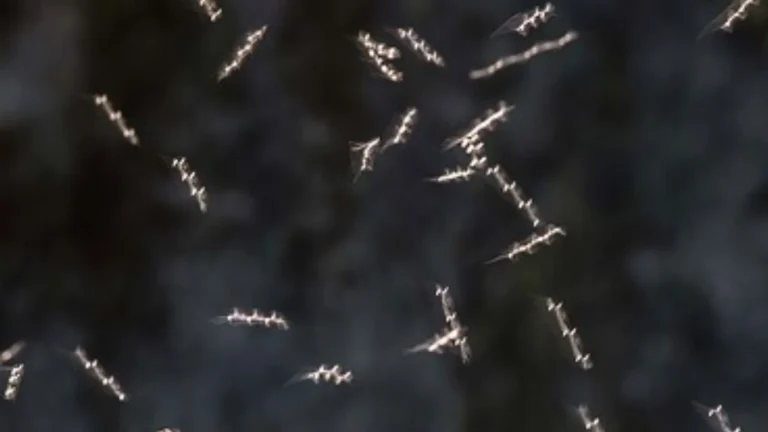For decades, mysterious phenomena known as “flying rods” or “skyfish” have fascinated and puzzled both scientists and enthusiasts alike. These elongated, rod-shaped objects appear in various parts of the world, often captured inadvertently in photographs and videos.
Despite numerous theories and investigations, the true nature of flying rod’s remains elusive. This article delves into the enigma of flying rods, exploring their characteristics, possible explanations, and the ongoing debate within the scientific community.
TRENDING
AI Campsite Finder: Discover Your Perfect Outdoor Escape
What Are Flying Rods?
Flying rods, also referred to as skyfish or sky rods, are elongated, cylindrical objects that appear to move through the air with an undulating motion. They are typically captured on film or video, often during outdoor activities such as hiking, skydiving, or even during weather monitoring.
These objects can vary in length, with some reported to be a few inches long, while others stretch up to several feet. Their peculiar movement and appearance have led to a wide array of theories regarding their origin and nature.
Characteristics Of Flying Rods
Appearance
Flying rod’s are generally characterized by their cylindrical shape and apparent wings or fin-like structures along their length. These appendages give them a resemblance to underwater creatures like squid or cuttlefish, contributing to their nickname “skyfish.” The appendages appear to beat or undulate as the rods move, creating the illusion of rapid flight.
Behavior
Most sightings of flying rod’s are brief, often lasting just a few seconds. They are typically observed in environments with good lighting, such as sunny days or well-lit interiors. Reports suggest that flying rod’s move at high speeds, making them difficult to spot with the naked eye but more readily captured by cameras, particularly those with high shutter speeds.
Theories And Explanations
Insect Theory
One of the most widely accepted theories is that flying rod’s are actually insects captured on film under specific conditions. According to this theory, the rod-like appearance is a result of motion blur caused by the rapid wing beats of flying insects. This explanation posits that the camera’s frame rate is not fast enough to resolve the individual wing movements, resulting in the characteristic rod shape with undulating wings.
Optical Illusion
Another theory suggests that flying rod’s are a form of optical illusion created by the interplay of light, shadow, and motion. Under certain lighting conditions and camera settings, ordinary objects such as birds, bats, or even debris can produce the appearance of a rod-like figure. This optical phenomenon can be exacerbated by the camera’s focus, depth of field, and the angle of view.
Extraterrestrial Hypothesis
While more controversial, some researchers and enthusiasts propose that flying rod’s may be of extraterrestrial origin. They suggest that these objects could be biological entities from another planet or dimension, or perhaps advanced surveillance technology used by extraterrestrial beings. However, this theory lacks substantial evidence and is often dismissed by the scientific community.
Investigations And Studies
Scientific Studies
Several scientific studies have been conducted to determine the nature of flying rods. High-speed cameras and controlled environments have been used to replicate the conditions under which flying rod’s are typically observed. These studies often support the insect theory, demonstrating that flying insects can indeed produce similar rod-like images when captured on camera.
Skeptical Investigations
Skeptical investigators have also played a significant role in demystifying flying rods. By analyzing video footage and conducting experiments, they have shown that many flying rod sightings can be attributed to insects, birds, or other mundane objects. Their work emphasizes the importance of critical thinking and scientific methodology in investigating unexplained phenomena.
Famous Sightings
Cave Of The Swallows, Mexico
One of the most famous flying rod sightings occurred at the Cave of the Swallows in Mexico. In the mid-1990s, a group of cavers captured footage of numerous flying rods within the cave. The footage sparked widespread interest and debate, with many speculating that the cave’s unique environment was conducive to the appearance of flying rods.
Beijing, China
In 2005, a security camera in Beijing captured footage of several flying rod’s in the sky. The footage quickly went viral, drawing attention from both the media and the scientific community. Subsequent investigations suggested that the rods were likely insects illuminated by the city’s bright lights.
The Role Of Technology
Advances In Camera Technology
Advances in camera technology have played a crucial role in both the proliferation and debunking of flying rod sightings. High-speed cameras with better resolution and frame rates have allowed for more detailed analysis of flying rod footage, often revealing the presence of insects or other ordinary objects.
Digital Analysis
Modern digital analysis tools enable researchers to enhance and scrutinize video footage in ways that were not possible in the past. By applying techniques such as frame-by-frame analysis, motion tracking, and image stabilization, investigators can better understand the factors contributing to the appearance of flying rods.
The Ongoing Debate
Despite extensive research and numerous plausible explanations, the phenomenon of flying rod’s continues to intrigue and divide opinion. While the insect theory remains the most widely accepted explanation, some researchers and enthusiasts continue to explore alternative possibilities, including the extraterrestrial hypothesis. The debate underscores the complexity of interpreting visual data and the human tendency to find patterns in ambiguous stimuli.
Conclusion
Flying rod’s represent one of the many enigmatic phenomena that challenge our understanding of the natural world. While scientific investigations have provided plausible explanations for many sightings, the true nature of flying rods remains a subject of fascination and debate.
Whether they are optical illusions, misidentified insects, or something more extraordinary, flying rods remind us of the importance of curiosity, critical thinking, and the continuous quest for knowledge.
By examining flying rods through the lens of scientific inquiry and skepticism, we can better appreciate the complexity of this phenomenon and the broader mysteries that continue to captivate the human imagination. As technology advances and new evidence emerges, we may one day unravel the true nature of these enigmatic objects in the sky.
ALSO READ: Python Health Check Daemon: Ensuring Continuous Wellness
FAQs
What Are Flying Rods?
Flying rods, also known as skyfish or sky rods, are elongated, cylindrical objects that appear to move through the air with an undulating motion. Often captured on film or video during outdoor activities, these mysterious entities have intrigued and puzzled observers due to their peculiar appearance and movement. Theories about their nature range from insects and optical illusions to more exotic explanations, but their true identity remains elusive.
How Are Flying Rods Captured on Camera?
Flying rods are typically captured by cameras, particularly those with high shutter speeds. They are often seen in environments with good lighting, such as sunny days or well-lit interiors. The rapid movement of these objects makes them difficult to spot with the naked eye, but camera footage can reveal their distinctive rod-like shape with apparent wings or fin-like structures.
What Are the Common Theories About Flying Rods?
Several theories attempt to explain the phenomenon of flying rods:
- Insect Theory: This widely accepted theory suggests that flying rods are insects captured on film with motion blur, creating the rod-like appearance.
- Optical Illusion: Some propose that flying rods result from the interplay of light, shadow, and motion, producing an illusion of rod-like figures.
- Extraterrestrial Hypothesis: A more controversial idea posits that flying rods could be biological entities from another planet or advanced surveillance technology.
Have There Been Scientific Studies on Flying Rods?
Yes, several scientific studies have investigated flying rods. Researchers have used high-speed cameras and controlled environments to replicate conditions under which flying rods are typically observed.
These studies often support the insect theory, showing that flying insects can produce similar rod-like images when captured on camera. Skeptical investigators have also analyzed video footage, attributing many sightings to insects, birds, or other mundane objects.
What Are Some Famous Sightings of Flying Rods?
One notable sighting occurred at the Cave of the Swallows in Mexico during the mid-1990s, where cavers captured footage of numerous flying rods. Another significant sighting happened in Beijing, China, in 2005, when a security camera recorded several flying rods in the sky. These sightings have sparked interest and debate, with investigations often pointing to insects or other ordinary objects as likely explanations.

